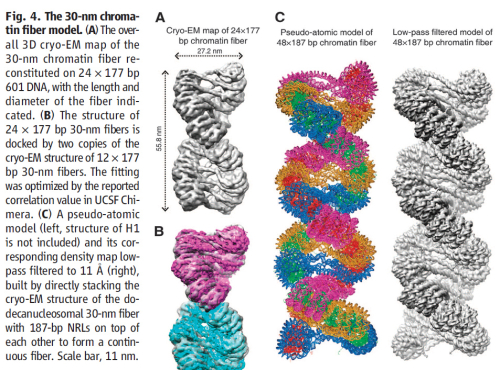The world leading scientific journal Science published a research article entitled “Cryo-EM Study of the Chromatin Fiber Reveals a Double Helix Twisted by Tetranucleosomal Units” on April 25, 2014. This article described a recent scientific breakthrough brought by scientists from the Institute of Biophysics, Chinese Academy of Sciences.
As we know, DNA is the carrier of genetic information. Each of us has long enough DNA to reach from the earth to the sun and back more than 300 times. But our entire DNA is packaged tightly through DNA-histone complex with higher-order structure and squeezed into tiny nucleus so that our bodies don’t need to grow up like giants. The DNA- histone complex is called chromatin. The packaging of chromatin plays a central role in transcriptional regulation and other DNA-related biological processes.
Studies have shown that by regulating chromatin structure within the nucleus (in particular the higher-order 30nm chromatin structure) , organisms can selectively activate or silence genes so as to control cell differentiation, tissue specificity, and cell fate. This phenomenon is called epigenetic regulation. However, the higher-order structure of chromatin has long been a "black box" to the researchers due to its tiny size and complexity.
IBP Professors ZHU Ping and LI Guohong have many years of close cooperation and unremitting efforts in studying chromatin structure. Collaborating with Professor XU Ruiming, a professor studying epigenetics at IBP, the researchers recently determined the three dimensional structure of the 30 nm chromatin fiber through cryo-electron microscopy utilizing a single particle reconstruction technique. They found, for the first time in the world, that the 30nm chromatin fiber is composed of smaller structural units. Each unit consists of 4 nucleosomes. These unites further form a higher-order left-handed double helical structure, opposite to the right-handed DNA double helical structure. At the same time, they also demonstrated for the first time that the linker histone H1 plays a critical role in the formation of the 30nm chromatin fiber.
One Science reviewer of the article comment on the achievement “How do nucleosome arrays fold into higher-order chromatin fibers remains a fundamental question in molecular biology. Over last three decades, solving the structure of the 30 nm fiber, …, remained a ‘holy grail’. The work … solving one of the most challenging biological structures”. Another reviewer comments on the study “… constitute the largest fragments of chromatin solved at this (or better) resolutions and,… constitute an important enough step forward in our understanding of how chromatin might pack …”.

(Song et al, Science,25 April 2014: Vol. 344 no. 6182 pp. 376-380,research article)
This work provides critical insight and assists us to better understand mechanisms of many important biological processes, including differential gene expression and genetic regulation during cell proliferation, development, and differentiation process, stem cell maintenance and differentiation, aging and abnormal development, and such complicated diseases as tumor, diabetes, psychiatric, and nervous system diseases.
This study is supported by funds from the Ministry of Science and Technology of China, the National Natural Science Foundation, the Chinese Academy of Sciences, and the Ministry of Education.